
Is Your Localized Learning Working? Here’s How to Tell
In 1997, sociologist Roland Robertson introduced the term glocalization at a conference. He described it as the phenomenon of simultaneously maintaining the co-presence of both “universalizing and particularizing tendencies.”
Expanding businesses across borders has become a key driver of success in an increasingly interconnected world. Establishing your business’s global presence and unlocking the untapped revenue streams of international markets is paramount. All of it begins with a crucial decision: localizing your content.
With the acceleration of remote culture in 2020, global workforces are expanding even further. Hence, Robertson’s prediction of the need for glocalization is even more relevant, especially in the context of corporate training.
Instead of delivering one-size-fits-all training programs, companies need to localize their global training efforts by making them inclusive but, more importantly, effective. Today, the localization software market, valued at $4.51 billion in 2021, is projected to grow to $ 6.64 billion by 2030. Hence, localization is fast becoming a best practice in the business world.
In this blog, we deconstruct what exactly corporate training localization is, its benefits, and how companies can leverage technology to help scale their efforts.
Table of Contents:
- What is Cultural Adaptation?
- Why Does Cultural Adaptation Matter in L&D?
- What is Corporate Training Localization?
- Why Should You Translate and Localize Workforce Learning Content?
- Best Practices for Translation and Localization
- Top Benefits of Corporate Training Localization
- How to Measure the Effectiveness of Translated and Localized Learning Content?
- Key Considerations While Choosing Localization and Translation Technology
- Conclusion
What is Cultural Adaptation?
Cultural adaptation or cross-cultural communication is the process of tailoring workforce training and development to suit the unique cultural contexts and preferences of diverse audiences. This involves understanding and addressing a particular group or community’s cultural nuances, customs, values, and preferences.
Cultural adaptation in workforce learning focuses on customizing training content, materials, and methodologies to bridge cultural gaps, promote understanding, and enhance engagement and knowledge retention among diverse groups and communities.
Why Does Cultural Adaptation Matter in L&D?
Cultural adaptation matters in L&D for several reasons:
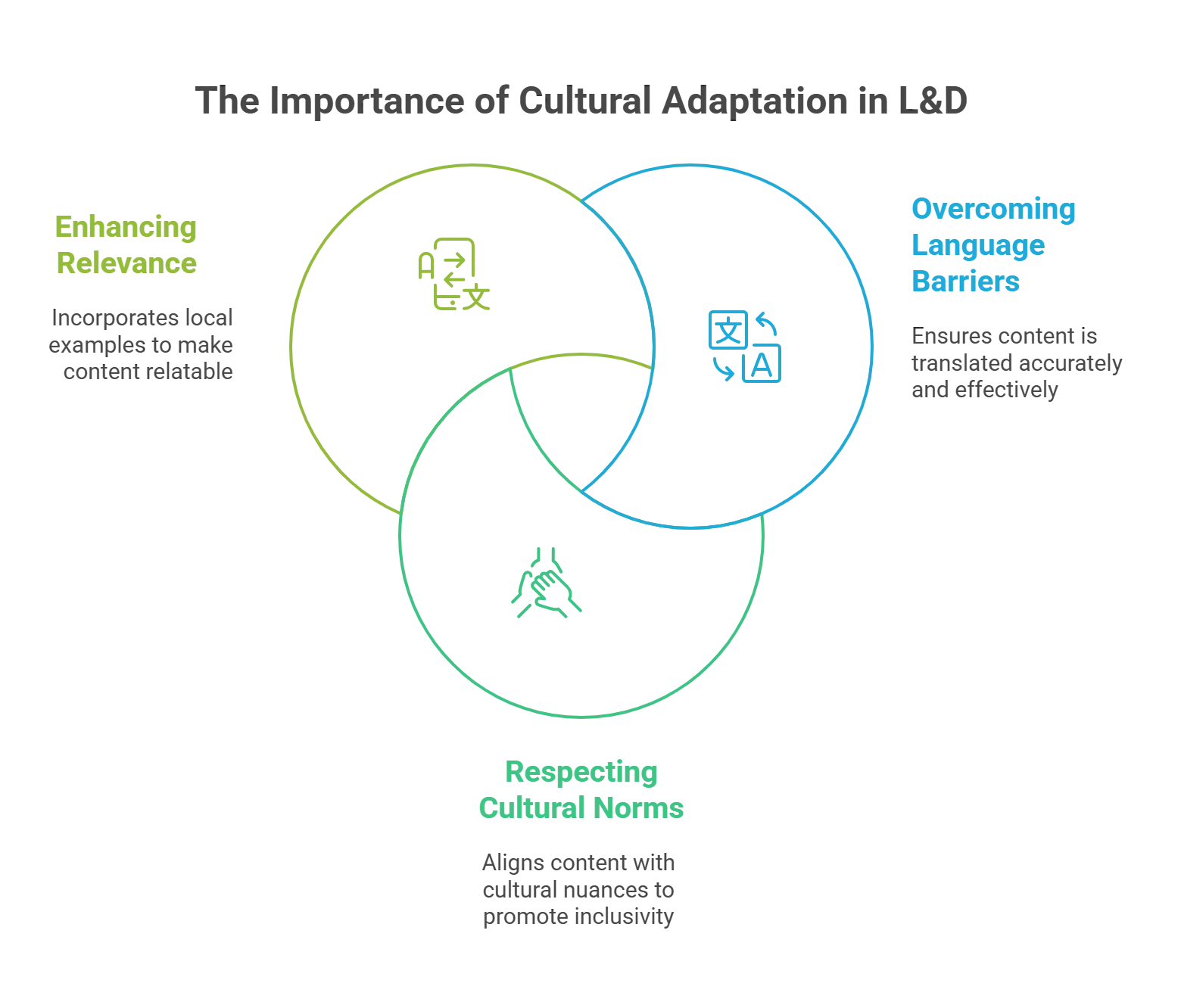
1. Helps Overcome Language Barriers
Cultural adaptation addresses the challenge of language barriers by ensuring that learning content is translated accurately and effectively. This is essential even if your programs are in English, since the proficiency of different regions in the language might change, requiring L&D programs to be in an easy-to-understand language.
2. Respects Cultural Norms and Values
Different cultures have distinct norms, values, and communication styles. Cultural adaptation allows organizations to align learning content with these cultural nuances, promoting respect and inclusivity.
It helps avoid potential misunderstandings in learning content due to cultural norms. For example, the thumbs-up sign denotes well done or agreement in the Western world but can be considered an insult in the Middle East.
3. Enhances Relevance and Applicability
Incorporating local examples, case studies, and references makes the content more relatable and applicable to learners’ daily work experiences.
What is Corporate Training Localization?
Today, factors such as advances in technology, the disruption of supply chains, hybrid work cultures, and fast-evolving regulatory guidelines, among others, are shifting business paradigms. There is a need to make corporate training a continuous and sustainable process.
According to the World Economic Forum, 1.1 billion jobs will likely undergo tech-related transformation in the coming decade. However, only 0.5% of the Global Gross Domestic Product (GDP) will be invested in learning for adults.
Hence, companies bear the onus of training. However, training programs need to be designed and delivered with a more contextual focus, especially when businesses expand with a national and international footprint. Here’s an example.
Say a global eCommerce marketplace is growing its digital footprint in multiple countries. Considering various factors, corporate training will need to be custom-designed and delivered to employees.
For instance, training may need to be delivered in multiple languages. However, it’s not enough to only pay attention to language. Training and development programs must also consider local culture and customs, to name a few, to make training more effective.
This is where corporate training localization comes into play. It is a practice of making corporate learning solutions relevant to the local context of employees in various parts of the world. Besides localizing text, images, and measurement units, aspects of communication, such as units, idioms, phrases, fonts, colors, narration tone, and the graphical user interface, are also localized.
Why Should You Translate and Localize Workforce Learning Content?
As multicultural, multilingual, and global workforces become more prevalent, companies are keen to find ways to adapt their workforce learning content to different cultures and localities. eLearning content localization adapts a training course to suit local needs and cultural sensitivities.
While translation involves converting the learning content from one language to another, localization adapts the content to suit a specific region’s cultural and linguistic context. Language and cultural factors are important in how learners perceive and comprehend training content.
When content is localized to suit the learner’s culture, they can better connect with the material, absorb it, and retain knowledge. If training content is not adapted to a particular culture or does not speak to the local context, learners may find it jarring or difficult to relate to.
Learners are also better able to learn when the training content is familiar to them or presented in a context that they are accustomed to. For instance, in Asian countries, learners may be accustomed to a more formal tone of instruction, while in Western countries, a more friendly tone may be appropriate.
Translating and localizing workforce learning content conveys to employees that your workplace is inclusive and takes all its different employees into account in enterprise learning. It helps employees feel valued and also helps them feel more engaged and involved in the training and learning process.
Lastly, learning in one’s native language improves an employee’s ability to comprehend the material and retain skills and knowledge.
Best Practices for Translation and Localization
Now that you understand the importance of translation and localization, let’s learn how you can bring eLearning content localization to your company.
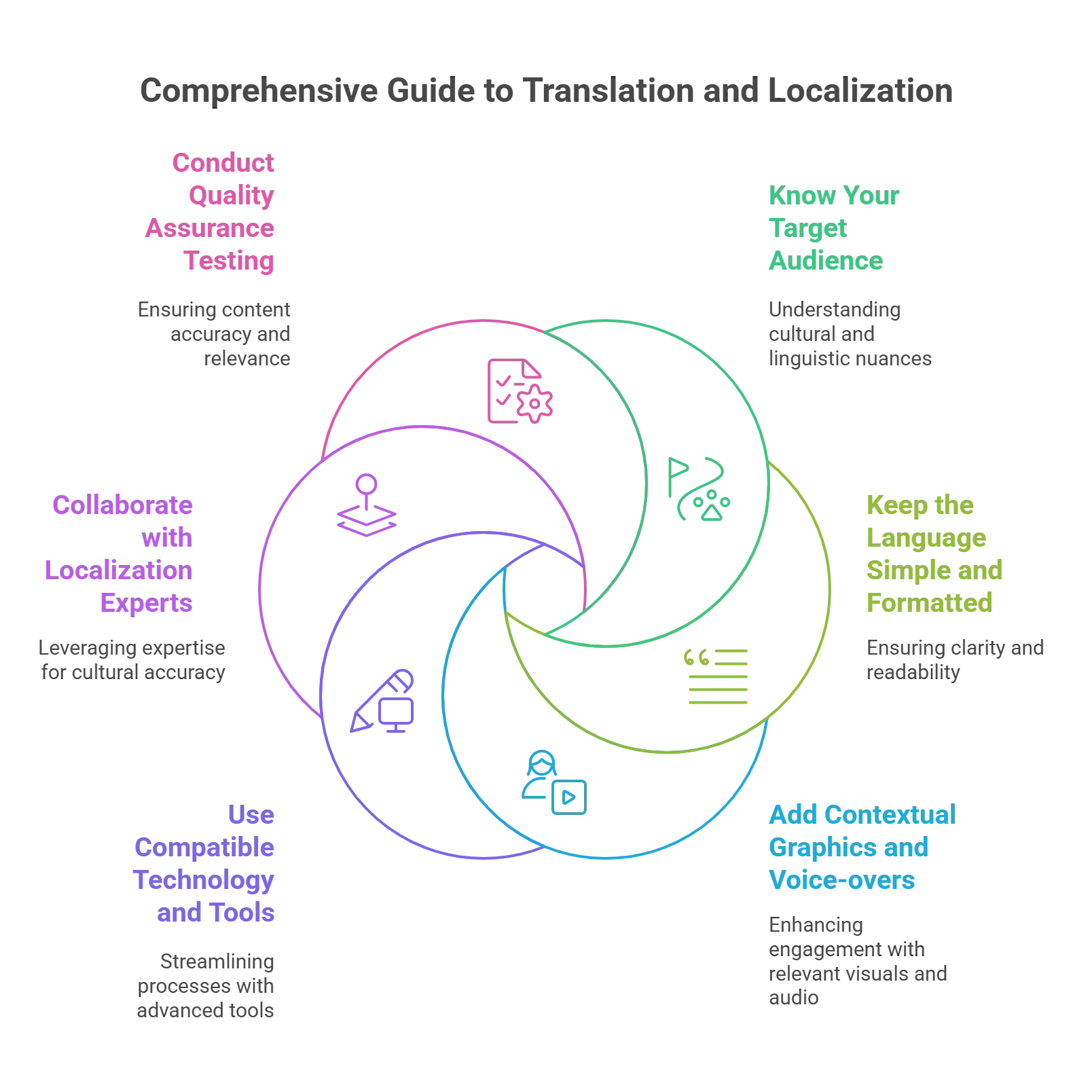
1. Know Your Target Audience
Before you begin user-centric localization, you should know who you are catering to. Gather information about your employees’ language, culture, country, laws, currencies, and technical standards.
Besides the language, also get to know the locale of your employees since language and locale can be different. For instance, the Spanish language spoken in Mexico, Argentina, Spain, etc., is different. It has regional differences and varies from one country to another. So, focusing on locale will help you create region-specific, high-quality learning content.
Once you know all these details about your employees, divide them into categories based on common characteristics of culture, locale, and country. This will make it easier for you to localize enterprise learning materials to their preferences.
2. Keep the Language Simple and Formatted
The language of your training materials should be simple and unambiguous. Using short, clear sentences and avoiding long, complex language can help you achieve that. This serves two purposes – one, it makes it easy for you to localize the content, and two, it makes it easy for your employees to understand the content of the training material.
Since different cultures and countries have different formatting styles, ensure that the text size, font, space, etc., are appropriate for your employees. Also, since some cultures read from right to left instead of left to right, ensure to leave enough white space for text expansion so that a hassle-free translation process can take place.
3. Add Contextual Graphics and Voice-overs
When adding graphics, you can incorporate images, diagrams, and graphs relevant to your employees’ cultural context or neutral graphics relevant across cultures. While the former creates a strong resonance with your employees, the latter fosters strong cross-cultural communication in training materials.
As far as voice-overs are concerned, choosing the right narrator for multilingual training materials is important. Usually, in Western countries, people expect the narrator’s voice to be friendly and informal, whereas in Asian countries, people expect a firm and authoritative voice.
4. Use Compatible Technology and Tools
Many tools and technologies are available to help your workforce learning and development teams streamline the translation and localization of learning content.
Translation technology and tools, such as machine translation software and translation management systems, can help your company generate error-free multilingual content quickly.
In addition, authoring tools like Adobe Captivate, Articulate Storyline, iSpring, etc., can localize eLearning courses by exporting your content in globally acceptable formats like .doc and XML files, localizing it, and placing it back in the eLearning courses.
Besides this, style guide tools can provide high-quality translations with minimal errors and create professional-looking training materials for your workforce.
5. Collaborate with Localization Experts
Collaborating with experts experienced in localizing workforce learning content can be very beneficial. The experts know the ins and outs of different cultures and languages and can provide you with language localization tips and other valuable insights.
Collaborating with a native expert can help you create culturally appropriate training materials that contain nuanced language with relevant idioms, phrases, and multimedia. Creating localized training material improves your employees’ engagement. It also adds an element of credibility and builds the trust of your employees and customers in your business.
6. Conduct Quality Assurance Testing
Once you have translated and localized workforce learning content, the final and most integral step before making the content available to your employees is quality assurance (QA) testing. It can be conducted by QA experts native to the target language or by a group representative of the target audience.
The QA testing helps experts see a preview of the final version of the training material and check whether any technical issues related to text fonts and sizes, color schemes, graphics, etc., exist. It also helps them check whether the content resonates with them and conveys the message effectively. In addition, it helps them make necessary last-minute changes if required.
Top Benefits of Corporate Training Localization
Here is a snapshot of key advantages delivered through the localization of corporate learning solutions:
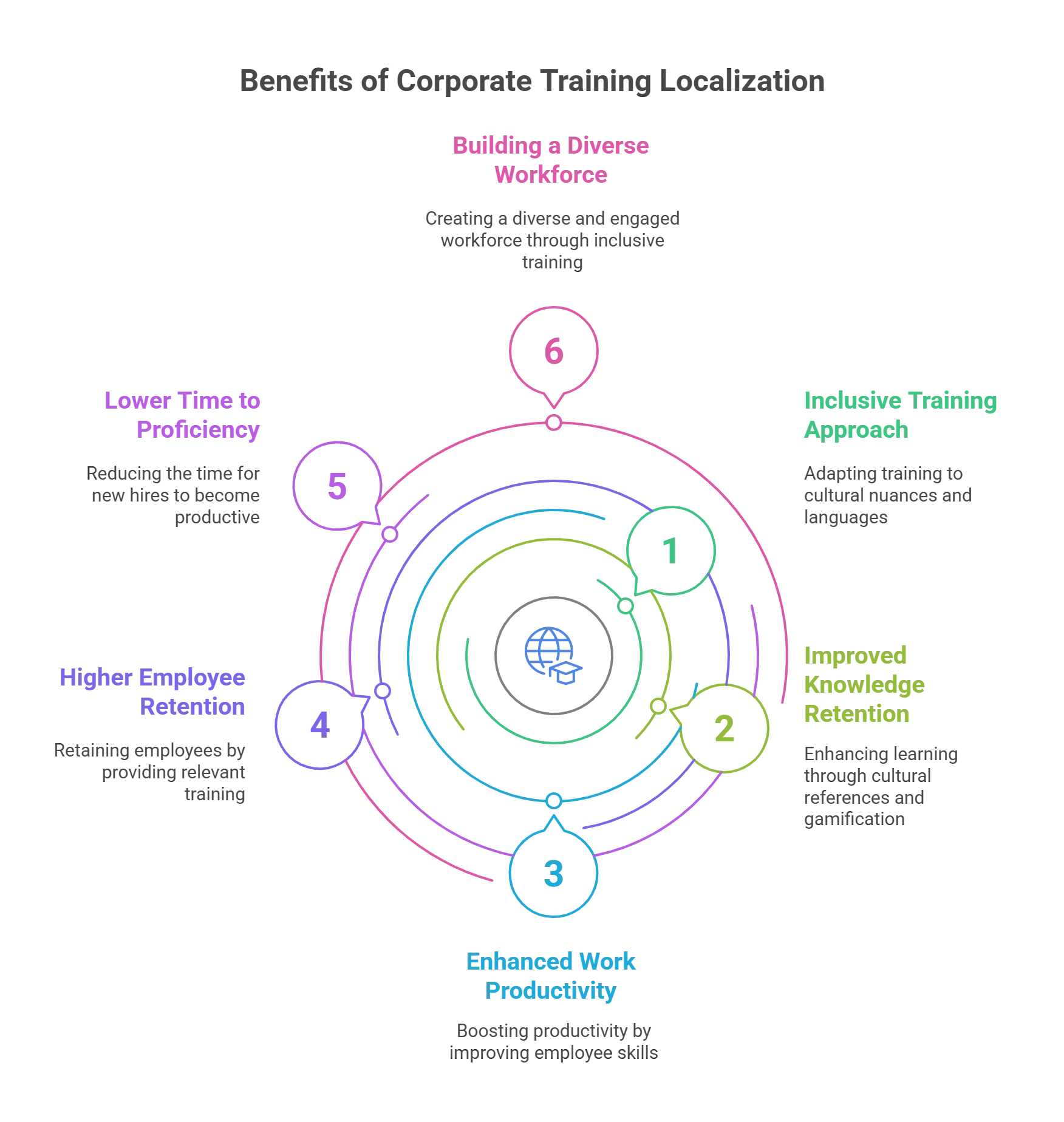
1. Inclusive Training Approach
The first benefit of corporate training localization is that it makes training more inclusive. Training is delivered in the language that employees are comfortable with. For instance, live session instructors will be savvy with the local language, and on-demand resources will be available in multiple languages.
However, localization goes much beyond removing language barriers. The entire training approach will be adapted to weave in cultural nuances and regional differences, thus building a safe space for sustained employee learning and engagement.
2. Improved Knowledge Retention
With the introduction of corporate training localization, employees are much more likely to retain knowledge and information. For instance, if the entire learning process is gamified and local cultural references are introduced into this journey, it can motivate employees to learn faster and more efficiently.
They will be positioned to be more engaged in the learning process. Learning stops being a one-way street. It becomes an interactive process that nurtures knowledge retention, paving the way for skill-building.
3. Enhanced Work Productivity
Companies are continuously striving to raise work productivity. A lack of skills demotivates employees and drives down productivity. On the other hand, employees engaged in continuous learning can face new market challenges and excel in their job roles.
Corporate training localization further enhances the learning curve of diverse employees. They become better problem solvers and leaders in their domain, contributing to the overall enhancement of work productivity.
4. Higher Employee Retention
Low productivity contributes to the trend of quiet quitting and employees moving on to other companies. The inability to perform one’s job role results in demotivation.
A lack of localization of digital learning solutions hinders employee growth. Employees are likely to prioritize a company that empowers them to grow through access to relevant, contextual training.
5. Lower Time to Proficiency
As companies expand to new locations, they may need to hire entire workforces from scratch. Corporate training localization can drastically reduce the time to proficiency for new hires.
This metric determines how long it takes for a new hire to become productive in the workplace. A shorter time to proficiency lowers the hiring cost and drives profitability.
6. Building a Diverse, Engaged Workforce
Increasing diversity is an important role of business today. Localizing corporate training enables businesses to hire a diverse workforce.
Employees can optimize their knowledge and performance through inclusive training rather than forcing a diverse set of people to adhere to one avatar of training.
Such a practice helps them learn faster and nudges them to be more engaged in the long-term business narrative. Corporate training localization seeds a foundation upon which future leaders from diverse geographies can be nurtured.
How to Measure the Effectiveness of Translated and Localized Learning Content?
There are several ways to measure the effectiveness of translated and localized learning content. It can be measured in terms of learner response to the material, learning process, learner performance in assessments, results in terms of applied knowledge in work, and learner satisfaction.
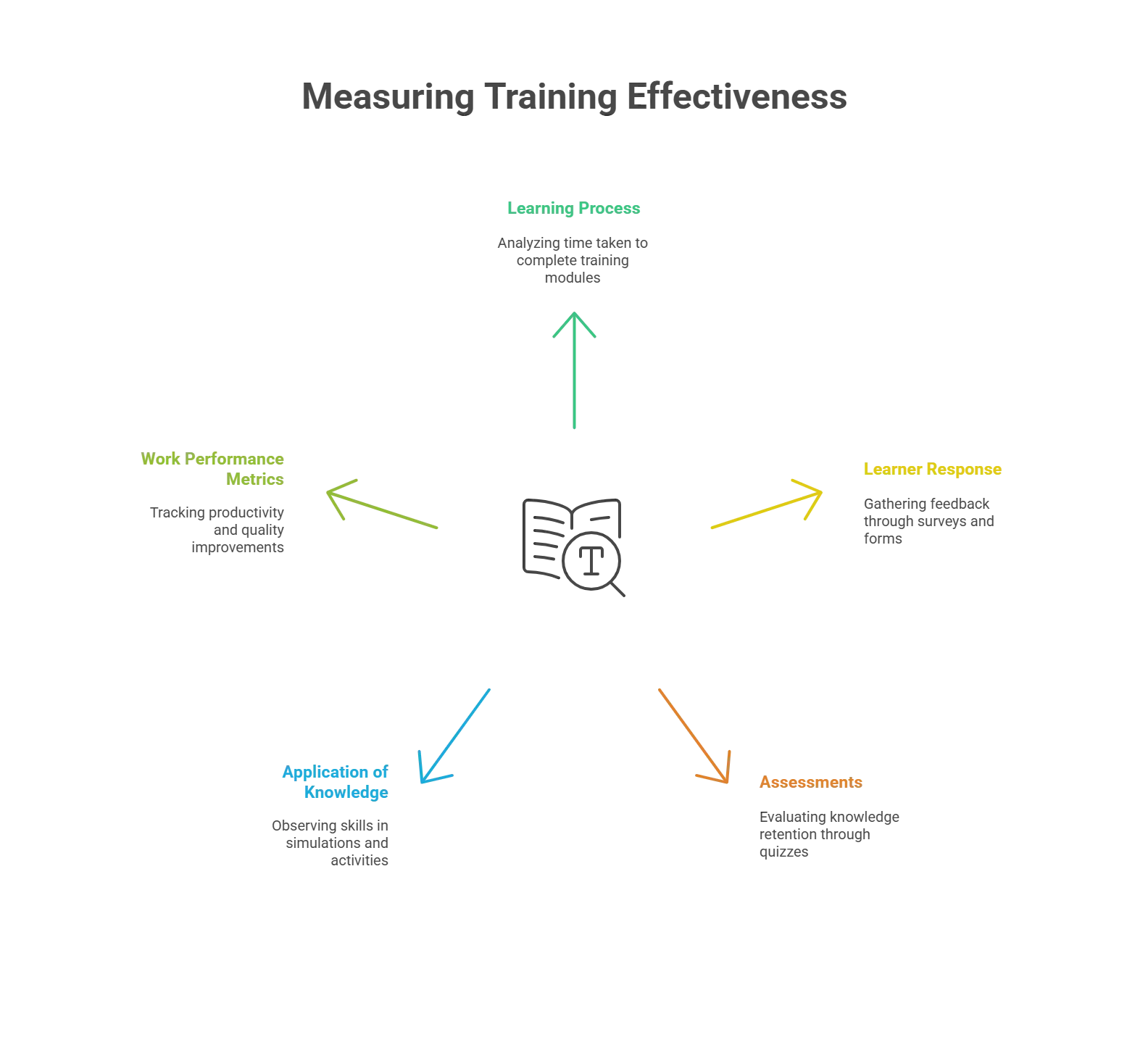
Here are some of the best ways to measure the effectiveness of translated and localized content for workforce learning and development.
1. Learning Process
The idea behind translating and localizing content is to make learning easier and more efficient.
You can utilize analytics tools of the Learning Management System (LMS) to check the time taken by learners in different regions to finish their training or to complete a particular module.
2. Learner Response
This level of measurement assesses learners’ responses to the training and their engagement with different parts of it.
Feedback forms and surveys are great ways to learn how learners respond to the content and get specific information about how they experienced particular aspects of training.
3. Assessments
Assessments help you measure how much participants are learning in the training. Measuring and analyzing data from assessments is one of the L&D best practices for businesses.
Assessment performance is a great way to gauge the knowledge acquired and retained by learners. While pre- and post-training assessments are an effective way to measure this, it can also be measured by assessments during the course.
Learning analytics can be used to analyze assessments, quiz scores, and the time taken to complete them to help you understand the effectiveness of knowledge retention. If employees can retain what they learned and complete assessments on time, it indicates that the training program is effective.
Certain analytic tools can also show area-specific data, indicating how employees are doing with different parts of the course and which areas they are finding more challenging.
4. Application of Knowledge and Skills
The main objective of localized and translated workforce learning content is to enable employees to more effectively transfer knowledge into skills. Employees’ ability to transfer knowledge into performance is a key indicator of the course’s effectiveness.
This could include hands-on skills, digital simulations, game-based activities, and other digital learning solutions. Online simulations provide life-like situations for employees to apply their knowledge and practice the skills they have learned.
This is a great way to collect data about the course’s effectiveness. Along with learner analytics, it can help you assess areas where there are gaps in knowledge transfer.
5. Work Performance Metrics
One of the main goals of translated and localized workforce training is to improve work performance. This is done through factors such as more efficient and improved quality of service, better productivity, and increased sales.
A change in these key performance metrics after the course can help you assess if the training has impacted employee work performance.
Analytics tools can help determine the effect of training across different teams or departments, allowing us to better understand which areas of the course are more effective and which are less effective.
Monitoring employees during work or comparing key performance metrics before and after the course are good ways to measure the effectiveness of the training.
Key Considerations While Choosing Localization and Translation Technology
Let’ see the key considerations while choosing the right technology, with which a world of efficient localization is within your reach:
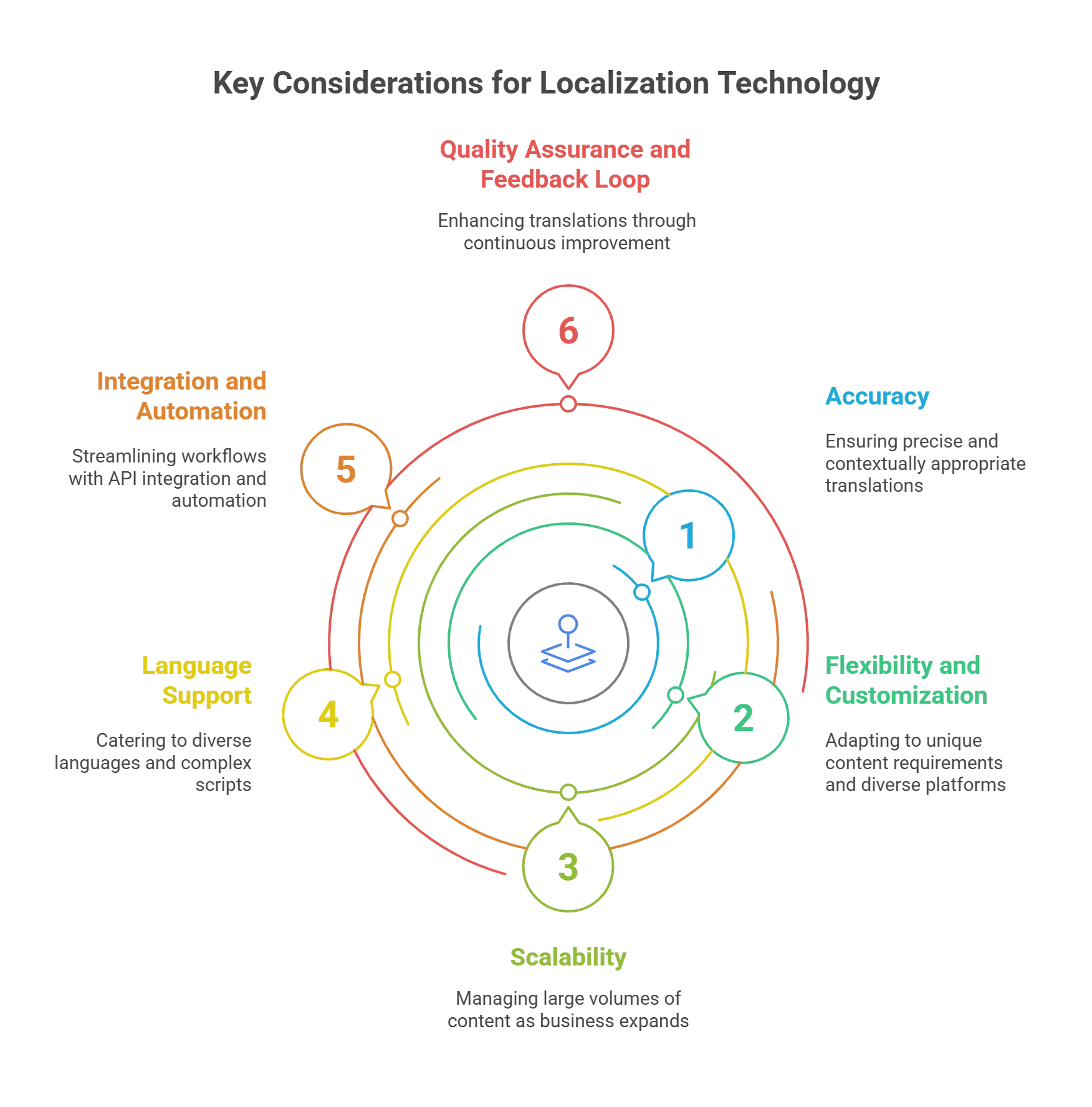
1. Accuracy
Translations riddled with inaccuracies and errors can negatively impact localization efforts. The importance of investing in localization technology equipped with robust quality assurance and proofreading tools cannot be understated. The chosen translation technology should be capable of delivering precise and contextually appropriate translations to ensure a higher level of precision in your localized content.
Machine Translation (MT) has advanced significantly since its early, frequently incorrect versions. Neural machine translation (NMT) systems offer fluent and contextually correct translations, transforming the field. NMT leverages neural networks and artificial intelligence algorithms to learn from massive volumes of data, enhancing the quality of translation.
This technology is perfect for swiftly and efficiently managing enormous amounts of content. Despite its progress, NMT can have trouble understanding intricate linguistic nuances and business-specific jargon. Further, human input through post-editing or a hybrid method can improve accuracy, especially for specific information.
2. Flexibility and Customization
With every business having its unique content requirements, choosing localization tools that can adapt to suit your specific needs is paramount. The translation tasks are abundant and diverse when crafting content for a global brand. The elements involving translation are innumerable, from websites and mobile apps to web applications, documents, and social media posts.
To effectively manage this multilingual endeavor, your Translation Management System (TMS) should be versatile enough to navigate the diverse linguistic landscape of translation projects and support a wide range of file formats across different platforms and media.
The ability to include glossaries and style guides greatly enhances consistency, enabling multinational brands to establish a unified style across all languages, going beyond just English. Look for platforms offering flexibility in integrating with existing content management systems (CMS) or localization workflows.
3. Scalability
As your business expands and ventures into new markets, the translation technology of choice should be able to scale accordingly. Ensure that the platform can manage large volumes of content to efficiently satisfy the needs of its clientele and deliver ongoing service reliably without compromising translation quality.
Consider features like automatic intelligent workflow management, batch processing, and collaboration tools to streamline the localization process and accelerate turnaround times.
4. Language Support
Determine the target languages you require for localization before investing in translation software to ensure both are compatible. While some translation technologies support diverse languages, others might have restrictions.
If your target markets include languages with complex grammar structures or scripts, such as Chinese or Arabic, ensure that the chosen technology can handle them effectively. Catering to varied markets and global audiences bridges the linguistic and cultural gaps, laying the foundation for success.
Additionally, monitor the availability of language pairs for translation, as this can vary among different tools.
5. Integration and Automation
Translating content between languages is a challenging task, made even more complex when dealing with regularly updated source material like websites. Maintaining up-to-date and accurate translations becomes virtually impossible without the proper tools.
Automation is the cornerstone of translation workflow optimization. Automation features such as content extraction, automatic file transfer, and project management are pivotal in reducing manual effort and enhancing overall efficiency.
Harnessing API integration can streamline your software localization efforts. Opt for translation technologies offering APIs or connectors to integrate with your CMS, e-commerce platforms, or customer support systems to enable the automatic delivery of completed translations, eliminating manual intervention and expediting the localization workflow.
6. Quality Assurance and Feedback Loop
Failure to align your technological infrastructure with the evolving needs of the translation services landscape is equivalent to inviting your downfall. Most businesses that made translation investments experienced a boost in their profits, based on a survey conducted among Fortune 500 companies. Embracing the latest advancements in translation technology is essential for staying ahead of the curve and thriving in this dynamic landscape.
Localization is an iterative process wherein a robust translation technology should extend mechanisms for quality assurance and feedback. Fine-tuning translations and ensuring consistent linguistic quality are made possible by functionalities like in-context review, collaborative annotation, and linguistic validation.
Go for platforms facilitating seamless communication with translators, providing a feedback loop that promotes continuous improvement. Translation solutions integrated with comprehensive reporting and analytics capabilities facilitate the assessment of localized content’s effectiveness and enable informed decision-making.
Conclusion
Effective corporate training solutions empower employees to build skills faster and engage more in the company’s mission. By integrating localization into this process, eLearning service providers can drive more effective learning outcomes. Today, businesses are leveraging enterprise learning tools to help localize learning modules in a scalable, cost-effective manner.
The best approach to introducing localization into your corporate training model is to partner with a seasoned technology specialist with experience customizing workforce learning.
If your business seeks to build globalized workforce learning and development solutions, Hurix Digital will support you with the technology and customization to meet your business needs. Our state-of-the-art Learning Management System is available as a subscription model.
Get in touch with us to start a conversation and turbocharge your company’s training needs.

Senior Vice President
Julia brings over 20 years of global experience in digital learning and business strategy. She specializes in client success, enterprise learning solutions, and driving growth through innovation, with a focus on AI, VR, and emerging technologies across diverse industry verticals.








